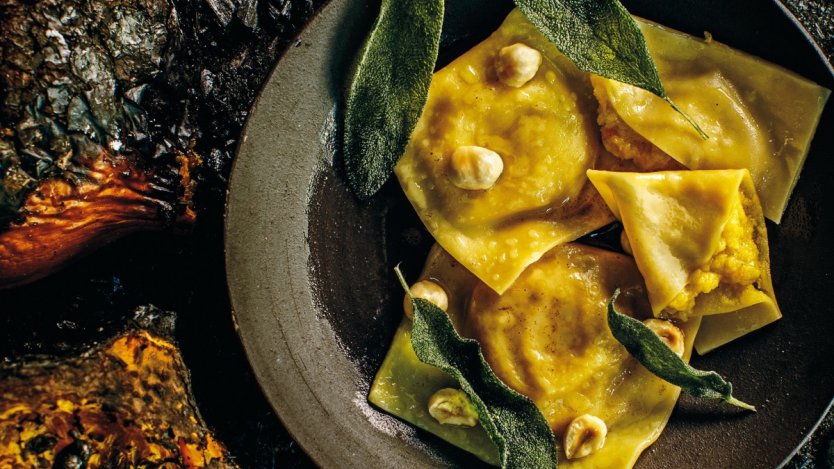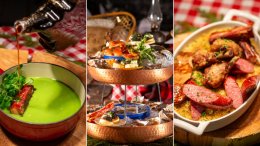Fewer things are as primal and satisfying as cooking over fire, and CinCin in Vancouver has mastered this in an elegant setting. Try making this fire-cooked squash ravioli at home, recipe from executive chef Andrew Richardson. You can roast the squash if you don't have access to a barbecue.
In terms of wine pairing, for a special occasion, crack open a bottle of Querciabella Batàr 2012, and for everyday drinking, Altesino Bianco 2013.
For the ravioli, divide the pasta dough into 4 pieces. Using a pasta machine, roll each piece out to the thinnest possible setting. A good test is to be able to read a newspaper through the dough. Dust a baking sheet or tray with semolina, and have more of it on hand. Dust the work surface with semolina, and lay out the 4 sheets of dough. The long side of the rectangle should be facing you.
Place the squash filling in a piping bag. For each sheet, pipe eight 1 tbsp (15 mL) rounds of the filling onto the dough along one side of the pasta sheet, about 1 inch (2.5 cm) apart.
Moisten the edges of the dough using cold water and a pastry brush. Fold the dough over the filling starting with the nearest edge. Press the dough together and press out any air pockets that may have formed. Cut through the pasta between each ravioli, and trim the edges. Set the ravioli aside on the prepared tray.
Have ready a small plate lined with a paper towel. To prepare the sage leaves, preheat canola oil in a deep fryer or small heavy-bottomed pot to 300° F. Pick the sage leaves from their stems, leaving about 1⁄4 inch (6 mm) of the stem intact. Drop the leaves into the fryer, and cook until they float on top of the oil and it stops bubbling, about 45 seconds. Drain on the paper towel.
Bring a pot of salted water to a boil over high heat. Drop the ravioli into the water, and cook for 4 minutes. If necessary, cook in 3 batches to avoid overcrowding the pot. Drain and place in a bowl or pan. Drizzle over some olive oil and add a pinch of salt.
To serve, divide the ravioli between 4 plates. Dress with the brown butter. Sprinkle 2 tbsp of hazelnuts over each plate. Grate over some of the pecorino and finish with 5 sage leaves. Serve.
Pasta dough
In a large bowl, whisk together the whole eggs. Using a scale, measure out exactly 3 3⁄8 oz. (95 g) of the whole eggs. In a small bowl, whisk together the egg yolks, and add exactly 1 3⁄4 oz (50 g) of the egg yolks to the whole eggs. (Save the rest of the egg for another use, or compost it.) Mix to combine, and whisk in the olive oil.
Add flour to food processor. With the food processor running at high speed, add the egg mixture in a slow, steady stream. Blend until the mixture has the texture of bread crumbs.
Turn out onto a work surface, and knead until the dough becomes silky and smooth, about 8 minutes. Roll into a ball. Using a knife, cut an X into the surface. Wrap in plastic wrap and place in the fridge to rest for 1 hour before use.
Squash filling
The squash can also be fire-cooked in the coals. Once the squash skin turns black, put it beside the coals and cook for an hour.
Alternatively, preheat the oven to 425° F.
Cut the squash into 6 pieces, and remove the seeds. Place on a baking sheet, brush with the olive oil and season with salt and pepper. Cook in the oven until soft and a knife cuts through very easily, about 1 hour and 45 minutes.
When cool enough to handle, scrape the flesh from the skin. Let it sit in a colander to drain any excess liquid. Pass the flesh through a food mill or push it through a coarse sieve, and set aside.
Heat the butter in a medium frying pan, and fry the onion until soft. Add the garlic, nutmeg, marjoram and chili. Cook just long enough to allow the flavours to blend. Add the squash, mix thoroughly and cool.
When cold, beat in the cheeses. Correct the seasoning.
Brown butter (beurre noisette)
Dice the butter into 1 Tbsp (15 mL) pieces.
Heat a large frying pan over medium heat. When it gets hot enough for the butter to immediately sizzle, add 4 pieces and swirl it around to melt. When the butter starts to brown (about 30 to 40 seconds), remove the pan from the heat. Watch constantly, as the butter will burn easily.
While standing back to avoid the sizzle and spit, squeeze some lemon juice into the butter. Add a pinch of salt and check the seasoning. The mixture should be heavily seasoned with a strong citrus flavour. Pour into a sealed container.
Wipe the pan with a paper towel. Repeat the process until all of the butter has been used.
The butter can be poured into a sealed container and stored in the fridge for up to a month.
- Yield:
- 4 servings







